集成电路电感变压器仿真设计
- 格式:ppt
- 大小:1.64 MB
- 文档页数:21
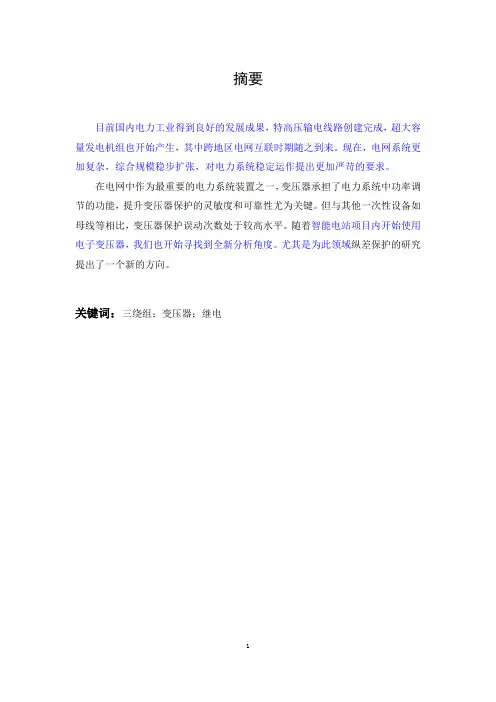
摘要目前国内电力工业得到良好的发展成果,特高压输电线路创建完成,超大容量发电机组也开始产生,其中跨地区电网互联时期随之到来。
现在,电网系统更加复杂,综合规模稳步扩张,对电力系统稳定运作提出更加严苛的要求。
在电网中作为最重要的电力系统装置之一,变压器承担了电力系统中功率调节的功能,提升变压器保护的灵敏度和可靠性尤为关键。
但与其他一次性设备如母线等相比,变压器保护误动次数处于较高水平。
随着智能电站项目内开始使用电子变压器,我们也开始寻找到全新分析角度。
尤其是为此领域纵差保护的研究提出了一个新的方向。
关键词:三绕组;变压器;继电SummaryWith the development and progress of electric power in our country, the continuous construction of UHV transmission lines, the increase of super-capacity units, the era of interconnection between regions has been gradually realized, and the complexity of power grid is gradually deepening.And the scale expands unceasingly, put forward the new request to the safe operation of the electric power system. As one of the most important electrical equipment in power system, transformer is carrying the role of power porter in the power network, so it is very important to improve the sensitivity and reliability of transformer protection. However, compared with other disposable equipment such as busbar, the statistics of misoperation times of transformer protection has always been at a relatively high level, and with the gradual use of electronic transformers in intelligent power plant projects, This brings a new research idea to transformer protection, especially the research direction of transformer longitudinal differential protection.Key words: three windings; Transformer; Relay目录摘要 (1)1 变压器保护Θ (5)1.1 励磁涌流 (7)2 继电保护装置原理 (9)2.1 纵差动保护 (9)2.2 变压器瓦斯保护 (9)2.3 平行双回线路横联方向差动保护 (9)2.4 复合电压启动的过电流 (10)2.5 变压器中性点直接接地零序电流保护工作原理 (10)2.6 过电流保护的构成及工作原理 (11)3 短路电流计算 (12)3.1 基本参数 (12)3.2画出短路等值电路 (13)3.3短路电流计算的过程 (14)3.4保护装置的配置 (15)4 各保护装置的整定计算 (16)4.1纵差保护的整定计算 (16)4.2 110kV侧复合电压启动过电流保护整定计算 (18)4.3 38.5kV侧方向过流保护 (18)4.4 110kV零序过电流保护 (19)4.5 变压器气体保护的整定 (19)5 差动元件基本原理 (20)5.1 差动元件的动作方程 (20)5.2 差动电流及制动电流的取得 (21)5.3 电流互感器二次接线进行相位补偿(外转角) (22)5.4 用保护内部算法进行相位补偿(内转角) (22)5.5 CT二次断线 (25)5.6 逻辑构成框图 (26)第六章三相变压器的仿真 (29)6.1 三相变压器仿真的数学模型 (29)6.2电源电压的描述 (34)6.3铁心动态磁化过程简述 (34)7 三绕组变压器的仿真与分析 (38)7.1空载合闸 (38)7.2内部故障 (40)结论 (48)致谢 (48)三绕组变压器纵差保护的设计与仿真1 变压器保护变压器是电力领域内不容忽视的重要装备,甚至影响整个系统的正常发电,供电与平稳运作。
![变压器与电感器设计方法及应用实例_变压器与电感器设计方法及应用实例_[共8页]](https://uimg.taocdn.com/3baa95d876c66137ef061935.webp)
电气工程应用技术丛书
变压器与电感器设计方法及应用实例
何此昂 周渡海编著
人民邮电出版社
北京
内容提要
本书首先介绍了变压器与电感器等电磁装置的设计原理,包括电磁装置的基本概念、原理性参数和计算方法,随后介绍了经典的铁芯电感器以及铁芯变压器的设计参数计算方法,并辅以设计实例,最后介绍了最新的电子式PCB型电感器、铁芯变压器的设计与计算方法以及应用设计实例。
本书的主要读者对象为从事变压器和电感器等电磁装置设计与生产制造的企业工程技术人员,以及研究电磁装置设计与制造的科研人员。
本书也可以作为高等院校电气工程、自动化、电子技术等相关专业的本专科生、研究生的参考资料。
电气工程应用技术丛书
变压器与电感器设计方法及应用实例
♦编著何此昂周渡海
责任编辑韦毅
♦人民邮电出版社出版发行北京市崇文区夕照寺街14号
邮编 100061 电子函件 315@
网址
北京艺辉印刷有限公司印刷
♦开本:787×1092 1/16
印张:14.75
字数:359千字2011年2月第1版
印数:1 – 3 000册2011年2月北京第1次印刷
ISBN 978-7-115-24477-2
定价:45.00元
读者服务热线:(010)67129264 印装质量热线:(010)67129223
反盗版热线:(010)67171154
广告经营许可证:京崇工商广字第0021号。
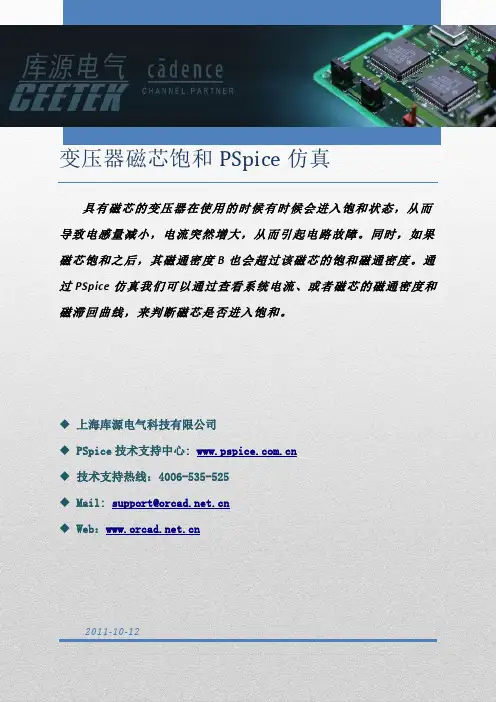
变压器磁芯饱和PSpice仿真具有磁芯的变压器在使用的时候有时候会进入饱和状态,从而导致电感量减小,电流突然增大,从而引起电路故障。
同时,如果磁芯饱和之后,其磁通密度B也会超过该磁芯的饱和磁通密度。
通过PSpice仿真我们可以通过查看系统电流、或者磁芯的磁通密度和磁滞回曲线,来判断磁芯是否进入饱和。
◆上海库源电气科技有限公司◆PSpice技术支持中心: ◆技术支持热线:4006-535-525◆Mail: support@◆Web:2011-10-12变压器磁芯饱和PSpice 仿真具有磁芯的变压器在使用的时候有时候会进入饱和状态,从而导致电感量减小,电流突然增大,从而引起电路故障。
同时,如果磁芯饱和之后,其磁通密度B 也会超过该磁芯的饱和磁通密度。
通过PSpice 仿真我们可以通过查看系统电流、或者磁芯的磁通密度和磁滞回曲线,来判断磁芯是否进入饱和。
下面举例来说明。
以一个理想变压器和一个实际磁芯变压器为例,如下图所示:图中上面的电路采用了一个3C90的真实磁芯做耦合,下面的电路是一个理想变压器。
在使用实际磁芯做耦合的情况下,两个耦合电感的Value 参数的含义指的是匝数,而理想变压器耦合指的是实际电感值。
对于ER28L_3C90磁芯,其电感系数A L 为2500nH/N 2,所以按照匝数的设置,其电感比值和下面的理想变压器相同,便于比较。
对于上面的电路,我们加入了一个直流电源,这样便于观察磁芯饱和。
进行1ms 的时域仿真,分别观察流过R1和R3的电流,如下图所示:0.50.5R1R210K K4COUPLING = 1K_LinearR3R410K LING=K51ER28L_3C90从上图中可以看出,流经实际磁芯的电流在0.76ms左右突然变大,说明此处磁芯已经进入饱和。
而理想变压器则是一直线性上升,没有进入饱和。
再观察3C90的磁通密度B(Bsat=4700G),如下所示:从图中可以看出,时间在0.76ms左右的时候B达到饱和值,与上面电流的分析相同。
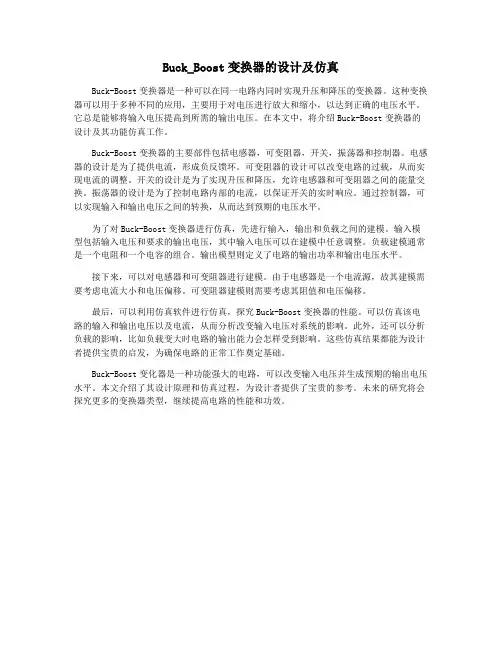
Buck_Boost变换器的设计及仿真Buck-Boost变换器是一种可以在同一电路内同时实现升压和降压的变换器。
这种变换器可以用于多种不同的应用,主要用于对电压进行放大和缩小,以达到正确的电压水平。
它总是能够将输入电压提高到所需的输出电压。
在本文中,将介绍Buck-Boost变换器的设计及其功能仿真工作。
Buck-Boost变换器的主要部件包括电感器,可变阻器,开关,振荡器和控制器。
电感器的设计是为了提供电流,形成负反馈环。
可变阻器的设计可以改变电路的过载,从而实现电流的调整。
开关的设计是为了实现升压和降压,允许电感器和可变阻器之间的能量交换。
振荡器的设计是为了控制电路内部的电流,以保证开关的实时响应。
通过控制器,可以实现输入和输出电压之间的转换,从而达到预期的电压水平。
为了对Buck-Boost变换器进行仿真,先进行输入,输出和负载之间的建模。
输入模型包括输入电压和要求的输出电压,其中输入电压可以在建模中任意调整。
负载建模通常是一个电阻和一个电容的组合。
输出模型则定义了电路的输出功率和输出电压水平。
接下来,可以对电感器和可变阻器进行建模。
由于电感器是一个电流源,故其建模需要考虑电流大小和电压偏移。
可变阻器建模则需要考虑其阻值和电压偏移。
最后,可以利用仿真软件进行仿真,探究Buck-Boost变换器的性能。
可以仿真该电路的输入和输出电压以及电流,从而分析改变输入电压对系统的影响。
此外,还可以分析负载的影响,比如负载变大时电路的输出能力会怎样受到影响。
这些仿真结果都能为设计者提供宝贵的启发,为确保电路的正常工作奠定基础。
Buck-Boost变化器是一种功能强大的电路,可以改变输入电压并生成预期的输出电压水平。
本文介绍了其设计原理和仿真过程,为设计者提供了宝贵的参考。
未来的研究将会探究更多的变换器类型,继续提高电路的性能和功效。
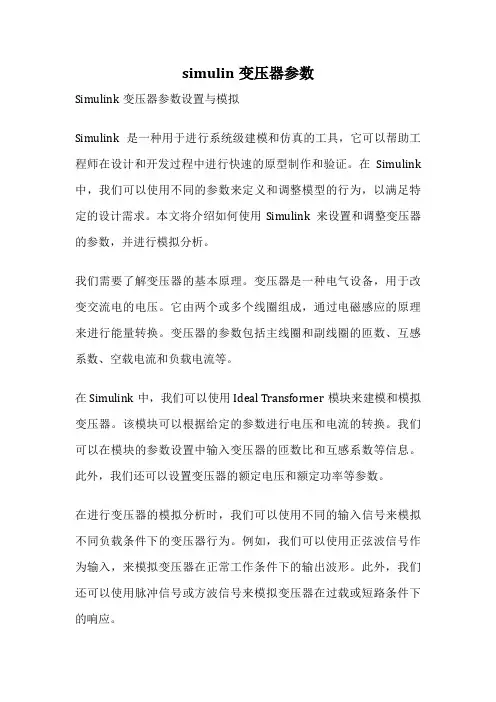
simulin变压器参数Simulink变压器参数设置与模拟Simulink是一种用于进行系统级建模和仿真的工具,它可以帮助工程师在设计和开发过程中进行快速的原型制作和验证。
在Simulink 中,我们可以使用不同的参数来定义和调整模型的行为,以满足特定的设计需求。
本文将介绍如何使用Simulink来设置和调整变压器的参数,并进行模拟分析。
我们需要了解变压器的基本原理。
变压器是一种电气设备,用于改变交流电的电压。
它由两个或多个线圈组成,通过电磁感应的原理来进行能量转换。
变压器的参数包括主线圈和副线圈的匝数、互感系数、空载电流和负载电流等。
在Simulink中,我们可以使用Ideal Transformer模块来建模和模拟变压器。
该模块可以根据给定的参数进行电压和电流的转换。
我们可以在模块的参数设置中输入变压器的匝数比和互感系数等信息。
此外,我们还可以设置变压器的额定电压和额定功率等参数。
在进行变压器的模拟分析时,我们可以使用不同的输入信号来模拟不同负载条件下的变压器行为。
例如,我们可以使用正弦波信号作为输入,来模拟变压器在正常工作条件下的输出波形。
此外,我们还可以使用脉冲信号或方波信号来模拟变压器在过载或短路条件下的响应。
通过调整Simulink模型中变压器的参数,我们可以观察和分析不同参数对变压器行为的影响。
例如,我们可以改变变压器的匝数比和互感系数,来观察输出电压和电流的变化情况。
此外,我们还可以改变变压器的额定电压和额定功率,来观察变压器在不同负载条件下的性能表现。
除了基本的参数设置外,Simulink还提供了其他高级功能,例如变压器的损耗模型和温升模型等。
这些功能可以更准确地模拟和分析变压器的行为,并帮助工程师进行系统级的优化和设计。
Simulink可以帮助工程师在设计和开发过程中对变压器的参数进行设置和调整,并进行模拟分析。
通过合理地设置参数和使用适当的输入信号,我们可以更好地理解和优化变压器的性能。
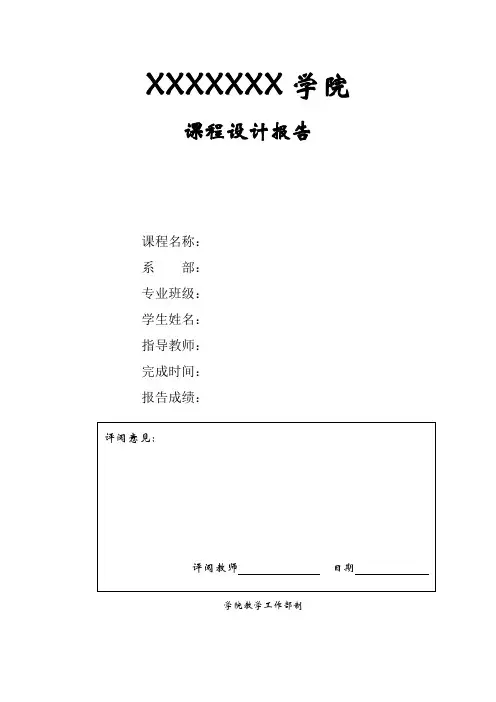
XXXXXXX学院课程设计报告课程名称:系部:专业班级:学生姓名:指导教师:完成时间:报告成绩:学院教学工作部制目录摘要 (3)第一章变压器介绍 (4)1.1 变压器的磁化特性 (4)1.2 变压器保护 (4)1.3 励磁涌流 (7)第二章变压器基本原理 (9)2.1 变压器工作原理 (9)2.2 三相变压器的等效电路及联结组 (10)第三章变压器仿真的方法 (11)3.1 基于基本励磁曲线的静态模型 (11)3.2基于暂态磁化特性曲线的动态模型 (13)3.3非线性时域等效电路模型 (14)第四章三相变压器的仿真 (16)4. 1 三相变压器仿真的数学模型 (16)4.2电源电压的描述 (20)4.3铁心动态磁化过程简述 (21)第五章变压器MATLAB仿真研究 (25)5.1 仿真长线路末端电压升高 (25)5.2 仿真三相变压器 T2 的励磁涌流 (28)5.3三相变压器仿真模型图 (34)5.4 变压器仿真波形分析 (36)结论 (40)参考文献 (41)摘要在电力变压器差动保护中,励磁涌流和内部故障电流的判别一直是一个关键问题。
文章阐述了励磁涌流的产生及其特性,利用 MATLAB 对变压器的励磁涌流、内部故障和外部故障进行仿真,对实验的数据波形分析,以此来区分故障和涌流,目的是减少空载合闸产生的励磁涌流对变压器差动保护的影响,提高保护的灵敏性。
本文在Matlab的编程环境下,分析了当前的变压器仿真的方法。
在单相情况下,分析了在饱和和不饱和的励磁涌流现象,和单相励磁涌流的特征。
在三相情况下,在用分段拟和加曲线压缩法的基础上,分别用两条修正的反正切函数,和两条修正的反正切函数加上两段模拟饱和情况的直线两种方法建立了Yd11、Ynd11、Yny0和Yy0四种最常用接线方式下三相变压器的数学仿真模型,并在Matlab下仿真实现。
通过对三相励磁涌流和磁滞回环波形分析,三相励磁涌流的特征分析,总结出影响三相变压器励磁涌流地主要因素。
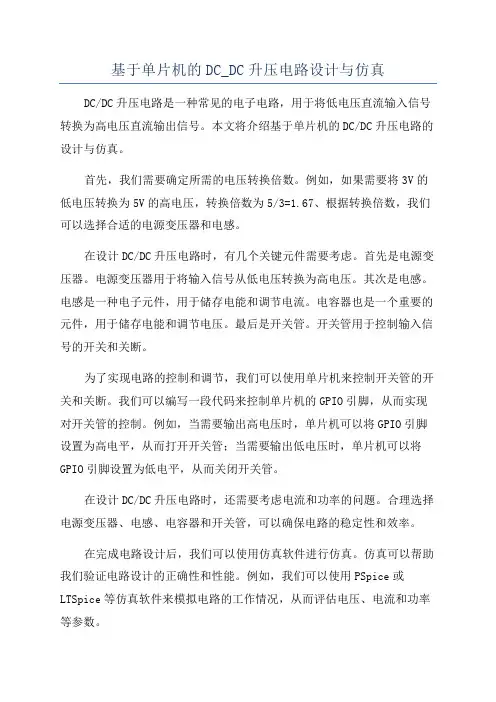
基于单片机的DC_DC升压电路设计与仿真DC/DC升压电路是一种常见的电子电路,用于将低电压直流输入信号转换为高电压直流输出信号。
本文将介绍基于单片机的DC/DC升压电路的设计与仿真。
首先,我们需要确定所需的电压转换倍数。
例如,如果需要将3V的低电压转换为5V的高电压,转换倍数为5/3=1.67、根据转换倍数,我们可以选择合适的电源变压器和电感。
在设计DC/DC升压电路时,有几个关键元件需要考虑。
首先是电源变压器。
电源变压器用于将输入信号从低电压转换为高电压。
其次是电感。
电感是一种电子元件,用于储存电能和调节电流。
电容器也是一个重要的元件,用于储存电能和调节电压。
最后是开关管。
开关管用于控制输入信号的开关和关断。
为了实现电路的控制和调节,我们可以使用单片机来控制开关管的开关和关断。
我们可以编写一段代码来控制单片机的GPIO引脚,从而实现对开关管的控制。
例如,当需要输出高电压时,单片机可以将GPIO引脚设置为高电平,从而打开开关管;当需要输出低电压时,单片机可以将GPIO引脚设置为低电平,从而关闭开关管。
在设计DC/DC升压电路时,还需要考虑电流和功率的问题。
合理选择电源变压器、电感、电容器和开关管,可以确保电路的稳定性和效率。
在完成电路设计后,我们可以使用仿真软件进行仿真。
仿真可以帮助我们验证电路设计的正确性和性能。
例如,我们可以使用PSpice或LTSpice等仿真软件来模拟电路的工作情况,从而评估电压、电流和功率等参数。
在进行仿真时,我们可以通过调整电源电压、电流和负载电阻等参数,来观察电路的工作情况。
如果电路存在问题,我们可以根据仿真结果进行修改和优化。
总之,基于单片机的DC/DC升压电路的设计与仿真是一个复杂的过程,需要考虑多个因素。
通过合理选择元件,使用单片机进行控制和调节,并进行仿真测试,可以确保电路的稳定性和效率。
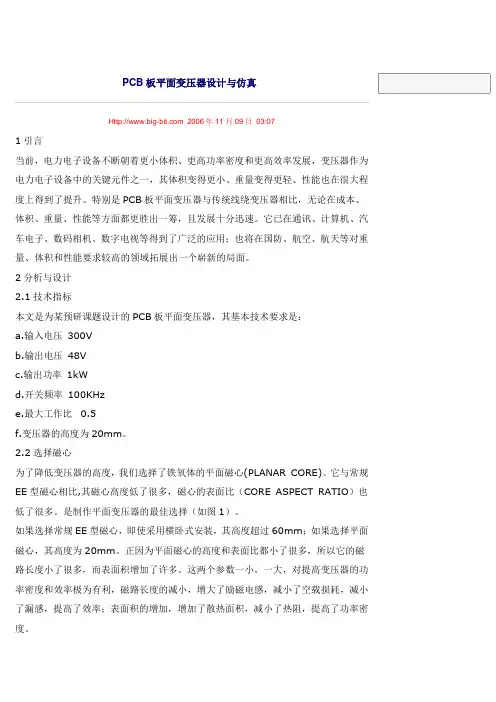
2006年11月09日03:071引言当前,电力电子设备不断朝着更小体积、更高功率密度和更高效率发展,变压器作为电力电子设备中的关键元件之一,其体积变得更小、重量变得更轻、性能也在很大程度上得到了提升。
特别是PCB板平面变压器与传统线绕变压器相比,无论在成本、体积、重量、性能等方面都更胜出一筹,且发展十分迅速。
它已在通讯、计算机、汽车电子、数码相机、数字电视等得到了广泛的应用;也将在国防、航空、航天等对重量、体积和性能要求较高的领域拓展出一个崭新的局面。
2分析与设计2.1技术指标本文是为某预研课题设计的PCB板平面变压器,其基本技术要求是:a.输入电压300Vb.输出电压48Vc.输出功率1kWd.开关频率100KHze.最大工作比0.5f.变压器的高度为20mm。
2.2选择磁心为了降低变压器的高度,我们选择了铁氧体的平面磁心(PLANAR CORE)。
它与常规EE型磁心相比,其磁心高度低了很多,磁心的表面比(CORE ASPECT RATIO)也低了很多。
是制作平面变压器的最佳选择(如图1)。
如果选择常规EE型磁心,即使采用横卧式安装,其高度超过60mm;如果选择平面磁心,其高度为20mm。
正因为平面磁心的高度和表面比都小了很多,所以它的磁路长度小了很多,而表面积增加了许多。
这两个参数一小,一大,对提高变压器的功率密度和效率极为有利,磁路长度的减小,增大了励磁电感,减小了空载损耗,减小了漏感,提高了效率;表面积的增加,增加了散热面积,减小了热阻,提高了功率密度。
2.3确定最佳磁感应强度B和最佳电流密度J在设计变压器时,如何确定最佳磁感应强度B和最佳电流密度J是设计变压器的关键。
对设计平面变压器尤其重要,因为对平面变压器来说,不能有设计余量。
如果有设计余量,那么它的体积、重量就无法减小。
为了设计计算方便快捷,我们建立了最佳磁感应强度和最佳电流密度的设计软件程序。
该套设计程序的界面非常简洁,一目了然,很容易操作。
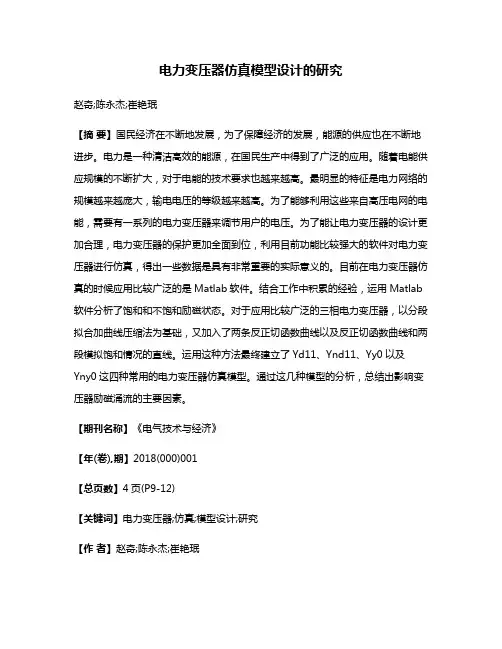
电力变压器仿真模型设计的研究赵奇;陈永杰;崔艳珉【摘要】国民经济在不断地发展,为了保障经济的发展,能源的供应也在不断地进步。
电力是一种清洁高效的能源,在国民生产中得到了广泛的应用。
随着电能供应规模的不断扩大,对于电能的技术要求也越来越高。
最明显的特征是电力网络的规模越来越庞大,输电电压的等级越来越高。
为了能够利用这些来自高压电网的电能,需要有一系列的电力变压器来调节用户的电压。
为了能让电力变压器的设计更加合理,电力变压器的保护更加全面到位,利用目前功能比较强大的软件对电力变压器进行仿真,得出一些数据是具有非常重要的实际意义的。
目前在电力变压器仿真的时候应用比较广泛的是Matlab软件。
结合工作中积累的经验,运用Matlab 软件分析了饱和和不饱和励磁状态。
对于应用比较广泛的三相电力变压器,以分段拟合加曲线压缩法为基础,又加入了两条反正切函数曲线以及反正切函数曲线和两段模拟饱和情况的直线。
运用这种方法最终建立了Yd11、Ynd11、Yy0以及Yny0这四种常用的电力变压器仿真模型。
通过这几种模型的分析,总结出影响变压器励磁涌流的主要因素。
【期刊名称】《电气技术与经济》【年(卷),期】2018(000)001【总页数】4页(P9-12)【关键词】电力变压器;仿真;模型设计;研究【作者】赵奇;陈永杰;崔艳珉【作者单位】[1]许继变压器有限公司;[1]许继变压器有限公司;[2]许继电气保护自动化系统公司【正文语种】中文【中图分类】TM411.20 引言(1)研究的主要内容目前电力网络的电压等级变换主要是通过变压器来实现的,在电力变压器的使用中,三相电力变压器又占主要部分。
本文的主要工作就是研究三相电力变压器。
根据电机学的基本原理,对三相变压器进行相关的理论分析和仿真计算,最终建立比较合理的电力变压器模型,这是本次研究的主要工作内容。
在具体的仿真研究过程中,主要包括以下的工作内容:1)研究相关的资料,总结目前仿真使用的理论方法,通过分析和简单的实验总结各种仿真方法的优缺点。
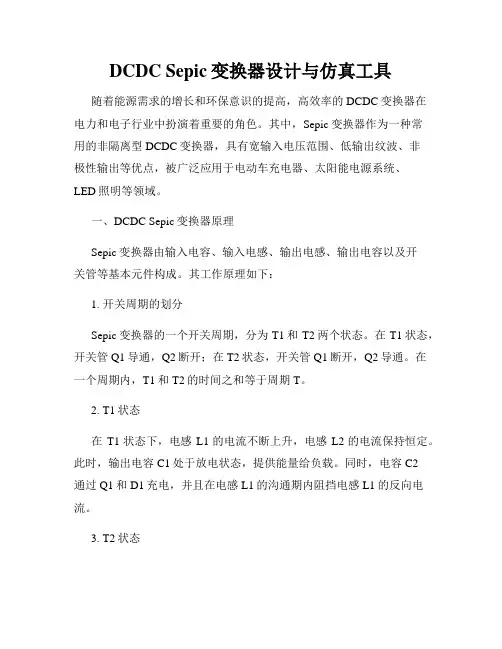
DCDC Sepic变换器设计与仿真工具随着能源需求的增长和环保意识的提高,高效率的DCDC变换器在电力和电子行业中扮演着重要的角色。
其中,Sepic变换器作为一种常用的非隔离型DCDC变换器,具有宽输入电压范围、低输出纹波、非极性输出等优点,被广泛应用于电动车充电器、太阳能电源系统、LED照明等领域。
一、DCDC Sepic变换器原理Sepic变换器由输入电容、输入电感、输出电感、输出电容以及开关管等基本元件构成。
其工作原理如下:1. 开关周期的划分Sepic变换器的一个开关周期,分为T1和T2两个状态。
在T1状态,开关管Q1导通,Q2断开;在T2状态,开关管Q1断开,Q2导通。
在一个周期内,T1和T2的时间之和等于周期T。
2. T1状态在T1状态下,电感L1的电流不断上升,电感L2的电流保持恒定。
此时,输出电容C1处于放电状态,提供能量给负载。
同时,电容C2通过Q1和D1充电,并且在电感L1的沟通期内阻挡电感L1的反向电流。
3. T2状态在T2状态下,Q1断开,Q2导通,电感L2的电流继续上升,并将电压传递给电容C1。
此时,电容C1处于充电状态,并且将电感L1的沟通期内的反向电流导向电容C2。
通过周期性的切换,Sepic变换器能够实现输入电压和输出电压之间的有效转换,以满足不同应用场景的需求。
二、Sepic变换器设计为了设计一个稳定可靠的Sepic变换器,需要考虑以下几个关键参数:1. 输入输出电压差在设计过程中,需根据应用场景确定Sepic变换器的输入输出电压差。
这个差值会直接影响到输出电压的稳定性和转换效率,需合理选择电容和电感元件的数值。
2. 开关管和二极管的选择由于Sepic变换器涉及到开关管和二极管的频繁开关,因此这两个元件的选择至关重要。
一方面要考虑开关管的导通电阻和导通损耗,另一方面要考虑二极管的反向恢复时间和反向电流等参数。
3. 控制方式Sepic变换器的控制方式一般有两种,分别是电压模式控制和当前模式控制。
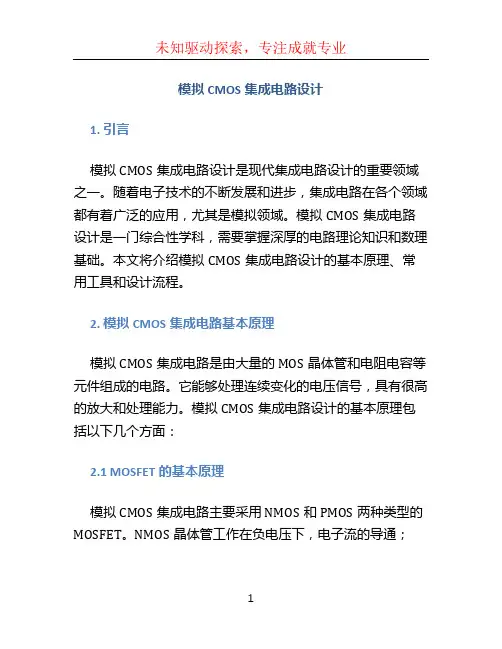
模拟CMOS集成电路设计1. 引言模拟CMOS集成电路设计是现代集成电路设计的重要领域之一。
随着电子技术的不断发展和进步,集成电路在各个领域都有着广泛的应用,尤其是模拟领域。
模拟CMOS集成电路设计是一门综合性学科,需要掌握深厚的电路理论知识和数理基础。
本文将介绍模拟CMOS集成电路设计的基本原理、常用工具和设计流程。
2. 模拟CMOS集成电路基本原理模拟CMOS集成电路是由大量的MOS晶体管和电阻电容等元件组成的电路。
它能够处理连续变化的电压信号,具有很高的放大和处理能力。
模拟CMOS集成电路设计的基本原理包括以下几个方面:2.1 MOSFET的基本原理模拟CMOS集成电路主要采用NMOS和PMOS两种类型的MOSFET。
NMOS晶体管工作在负电压下,电子流的导通;PMOS晶体管工作在正电压下,空穴流的导通。
MOSFET的基本原理和参数是设计模拟CMOS电路的基础。
2.2 CMOS反相放大器CMOS反相放大器是模拟CMOS电路的基本模块。
它能够将输入电压放大并反向输出。
通过设计合适的电路结构和参数,可以实现不同的放大倍数和频率响应。
2.3 模拟CMOS电路的环路增益模拟CMOS电路的环路增益是指电路反馈回路的增益。
环路增益对电路的稳定性和性能有重要影响。
通过选择合适的电路结构和控制参数,可以提高电路的稳定性和性能。
3. 模拟CMOS集成电路设计工具3.1 SPICE仿真工具SPICE(Simulation Program with Integrated Circuit Emphasis)是一种广泛使用的电路仿真工具。
它能够模拟和分析模拟CMOS电路的性能,帮助设计师进行电路参数优化和性能评估。
3.2 Cadence工具套件Cadence是一套综合性的集成电路设计工具套件。
它包括了原理图设计、布局设计、电路仿真和物理验证等模块,可以实现从概念到最终产品的全流程设计。
3.3 ADS高频仿真工具ADS(Advanced Design System)是一种专业的高频电路仿真工具。
变压器励磁电感等效电路
首先,让我们来看看励磁电感等效电路的基本结构。
该电路通常包括一个电感元件,代表了变压器的主磁路的磁感应强度,以及一个电阻元件,代表了磁芯中的铁损耗和涡流损耗。
这两个元件一起构成了励磁电感等效电路的基本模型。
其次,让我们来探讨一下励磁电感等效电路的作用。
励磁电感等效电路可以帮助工程师和研究人员更好地理解变压器在励磁状态下的电气特性,包括磁化曲线、励磁电流和励磁电压之间的关系。
通过这个等效电路模型,我们可以更好地分析和计算变压器在实际工程中的性能。
此外,励磁电感等效电路还可以用于仿真和计算。
在电力系统分析和设计中,我们经常需要对变压器在不同工况下的响应进行仿真和计算。
励磁电感等效电路可以作为一个简化的模型,帮助我们进行这些仿真和计算工作。
最后,让我们来思考一下励磁电感等效电路的局限性。
虽然励磁电感等效电路可以很好地描述变压器的励磁特性,但它仍然是一个简化模型,无法完全准确地反映变压器的复杂行为。
在实际工程
中,我们可能还需要考虑更多的因素,如温升效应、饱和效应等。
因此,在使用励磁电感等效电路进行分析和设计时,我们需要注意其局限性,并结合实际情况进行综合考虑。
总的来说,励磁电感等效电路是描述变压器在励磁状态下电气特性的重要模型,它有助于我们更好地理解和分析变压器的性能,但在实际应用中仍需谨慎对待其简化模型的局限性。
2006年11月09日03:071引言当前,电力电子设备不断朝着更小体积、更高功率密度和更高效率发展,变压器作为电力电子设备中的关键元件之一,其体积变得更小、重量变得更轻、性能也在很大程度上得到了提升。
特别是PCB板平面变压器与传统线绕变压器相比,无论在成本、体积、重量、性能等方面都更胜出一筹,且发展十分迅速。
它已在通讯、计算机、汽车电子、数码相机、数字电视等得到了广泛的应用;也将在国防、航空、航天等对重量、体积和性能要求较高的领域拓展出一个崭新的局面。
2分析与设计2.1技术指标本文是为某预研课题设计的PCB板平面变压器,其基本技术要求是:a.输入电压300Vb.输出电压48Vc.输出功率1kWd.开关频率100KHze.最大工作比0.5f.变压器的高度为20mm。
2.2选择磁心为了降低变压器的高度,我们选择了铁氧体的平面磁心(PLANAR CORE)。
它与常规EE型磁心相比,其磁心高度低了很多,磁心的表面比(CORE ASPECT RATIO)也低了很多。
是制作平面变压器的最佳选择(如图1)。
如果选择常规EE型磁心,即使采用横卧式安装,其高度超过60mm;如果选择平面磁心,其高度为20mm。
正因为平面磁心的高度和表面比都小了很多,所以它的磁路长度小了很多,而表面积增加了许多。
这两个参数一小,一大,对提高变压器的功率密度和效率极为有利,磁路长度的减小,增大了励磁电感,减小了空载损耗,减小了漏感,提高了效率;表面积的增加,增加了散热面积,减小了热阻,提高了功率密度。
2.3确定最佳磁感应强度B和最佳电流密度J在设计变压器时,如何确定最佳磁感应强度B和最佳电流密度J是设计变压器的关键。
对设计平面变压器尤其重要,因为对平面变压器来说,不能有设计余量。
如果有设计余量,那么它的体积、重量就无法减小。
为了设计计算方便快捷,我们建立了最佳磁感应强度和最佳电流密度的设计软件程序。
该套设计程序的界面非常简洁,一目了然,很容易操作。
变压变频器设计及MATLAB仿真变压变频器的设计主要包括变频控制器设计和变压器设计两个部分,其中变频控制器设计是变压变频器的关键。
变频控制器主要功能是通过控制电子开关管的导通与截止时间比,控制输入电源的交流电压,以实现输出电压的变频和变压。
通常采用PWM调制方式控制开关电路中的开通时间,从而控制输出波形的频率和幅度。
变频控制器设计一般包括控制策略选择、电路拓扑设计、开关器件选择和参数计算等步骤。
常用的控制策略有V/F控制、电压调制控制和电流调制控制等。
根据实际需求选择合适的控制策略,并确定相应的参数,如输出电压、频率范围等。
然后设计电路拓扑结构,选择合适的开关器件,如MOSFET管、IGBT等。
根据选定的开关器件,进行参数计算,包括电路电感、电容、阻抗等。
最后通过Matlab仿真验证设计的可行性和性能。
变压器设计是变压变频器设计中的另一个重要环节。
变压器的设计首先需要确定输入和输出的电压、电流等参数,然后选择合适的铁心材料和绕组方式。
根据输入输出参数计算铁心和铜线的尺寸,然后绘制变压器的原理图。
通过Matlab仿真验证变压器的性能。
变压变频器的MATLAB仿真主要通过搭建电路模型,根据电路参数仿真输出波形,并通过输出波形与理论计算结果进行验证。
可以采用Simulink软件进行建模与仿真,通过调整参数和控制策略,优化输出波形和性能。
总之,变压变频器的设计和MATLAB仿真需要从控制策略选择、电路拓扑设计、开关器件选择和参数计算等方面进行综合考虑,通过MATLAB仿真验证设计的可行性和性能,以实现电能的变频和变压。
扬州大学专业软件应用综合设计报告水能学院13级电气专业题目变压器综合仿真设计二学生某某某学号131504207指导教师张建华2015年12月30日目录一、设计题目 (2)二、正文 (2)1、引言 (2)2、设计依据及框图 (3)2.1 设计平台 (3)2.2 设计思想 (4)2.3 设计结构框图或流程图 (6)2.4各模块功能简介 (6)3、软件调试分析 (10)4、结语 (23)5、参考文献 (25)6、致谢 (25).变压器综合仿真设计二摘要:随着变压器技术的进步,传统仿真已经受到了很大的限制。
并且当下要推动变压器技术的发展,已经不能再依靠传统仿真。
因此,对于变压器的计算机仿真技术势在必行。
本为通过MATLAB软件,对变压器的运行特性进行了仿真。
主要仿真的内容包括:变压器磁路电流畸变以及变压器负载运行特性曲线研究。
仿真所用到的方法为数值计算方法,通过插值的方法实现了对曲线的拟合。
仿真时,结合实际情况可输入不同参数便于研究。
文中给出了各种运行特性的仿真结果图,并且结合理论对其做了简单的分析,验证了仿真方法的准确性和可行性。
关键字:变压器;MATLAB仿真分析;曲线拟合1 引言设随着科学技术进步,电工电子新技术的不断发展,新型电气备不断涌现,人们使用电的频率越来越高,人与电的关系也日益紧密,对于电性能和电气产品的了解,已成为人们必需的生活常识。
变压器是一种静止的电气设备,它是利用电磁感应原理把一种电压的交流电能转变成同频率的另一种电压的交流电能,以满足不同负载的需要。
在电力系统中,变压器是一个重要的电气设备,它对电能的经济传输,灵活分配和安全使用具有重要的作用,此外,也使人们能够方便地解决输电和用电这一矛盾。
由于计算机仿真技术的出现,传统的物理仿真系统逐渐的被计算机仿真系统代替。
计算机仿真系统所具有的效率高、精度高、重复性和通用性好、容易改变仿真参数等优点,还可以实现物理仿真无法实现的有危险性的或者是成本昂贵的仿真。
Saber 仿真开关电源中变压器的Saber仿真辅助设计 (2)一、Saber在变压器辅助设计中的优势 (2)二、Saber 中的变压器 (3)三、Saber中的磁性材料 (7)四、辅助设计的一般方法和步骤 (9)1、开环联合仿真 (9)2、变压器仿真 (10)3、再度联合仿真 (11)五、设计举例一:反激变压器 (12)五、设计举例一:反激变压器(续) (15)五、设计举例一:反激变压器(续二) (19)Saber仿真实例共享 (26)6KW移相全桥准谐振软开关电焊电源 (27)问答 (28)开关电源中变压器的Saber仿真辅助设计经常在论坛上看到变压器设计求助,包括:计算公式,优化方法,变压器损耗,变压器饱和,多大的变压器合适啊?其实,只要我们学会了用Saber这个软件,上述问题多半能够获得相当满意的解决。
一、Saber在变压器辅助设计中的优势1、由于Saber相当适合仿真电源,因此对电源中的变压器营造的工作环境相当真实,变压器不是孤立地被防真,而是与整个电源主电路的联合运行防真。
主要功率级指标是相当接近真实的,细节也可以被充分体现。
2、Saber的磁性材料是建立在物理模型基础之上的,能够比较真实的反映材料在复杂电气环境中的表现,从而可以使我们得到诸如气隙的精确开度、抗饱和安全余量、磁损这样一些用平常手段很难获得的宝贵设计参数。
3、作为一种高性能通用仿真软件,Saber并不只是针对个别电路才奏效,实际上,电力电子领域所有电路拓扑中的变压器、电感元件,我们都可以把他们置于真实电路的仿真环境中来求解。
从而放弃大部分繁杂的计算工作量,极大地加快设计进程,并获得比手工计算更加合理的设计参数。
saber自带的磁性器件建模功能很强大的,可以随意调整磁化曲线。
但一般来说,用mast模型库里自带的模型就足够了。
二、Saber 中的变压器我们用得上的 Saber 中的变压器是这些:(实际上是我只会用这些分别是:xfrl 线性变压器模型,2~6绕组xfrnl 非线性变压器模型,2~6绕组单绕组的就是电感模型:也分线性和非线性2种线性变压器参数设置(以2绕组为例):其中:lp 初级电感量ls 次级电感量np、ns 初级、次级匝数,只是显示用,不是真参数,可以不设置rp、rs 初级、次级绕组直流电阻值,默认为0,实际应该是该绕组导线的实测或者计算电阻值,在没有得到准确数据前,建议至少设置一个非0值,比如1p(1微微欧姆)k 偶合(互感)系数,建议开始设置为1,需要考虑漏感影响时再设置为低于1的值。